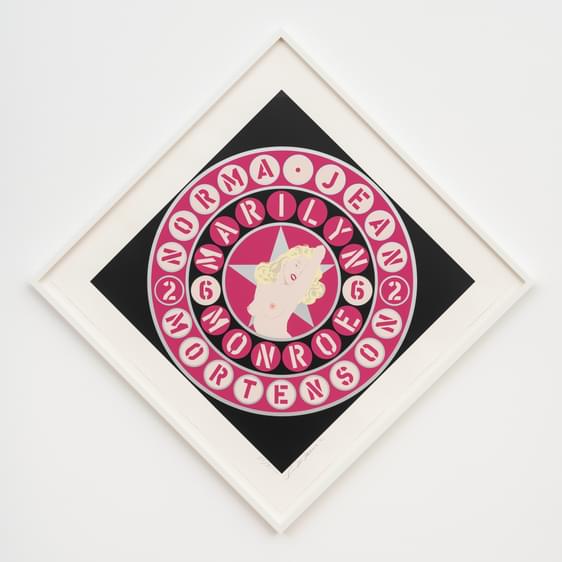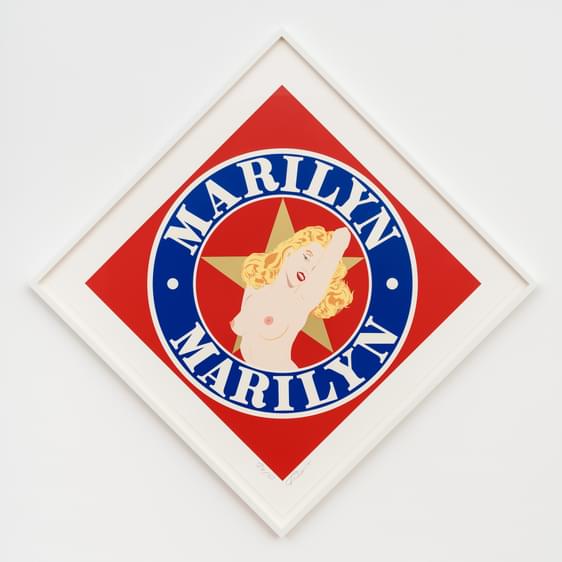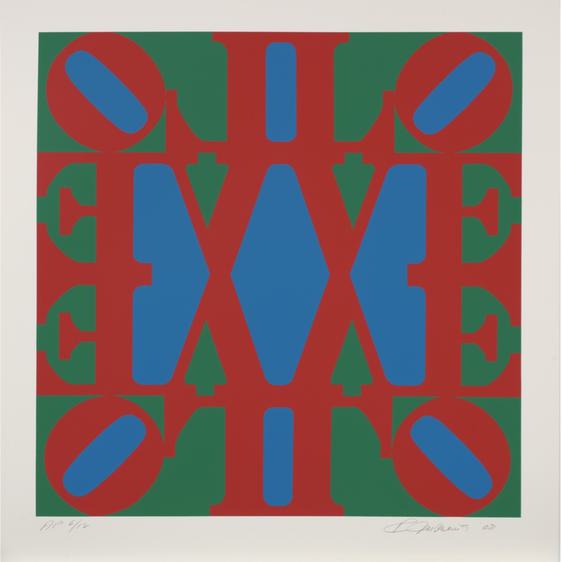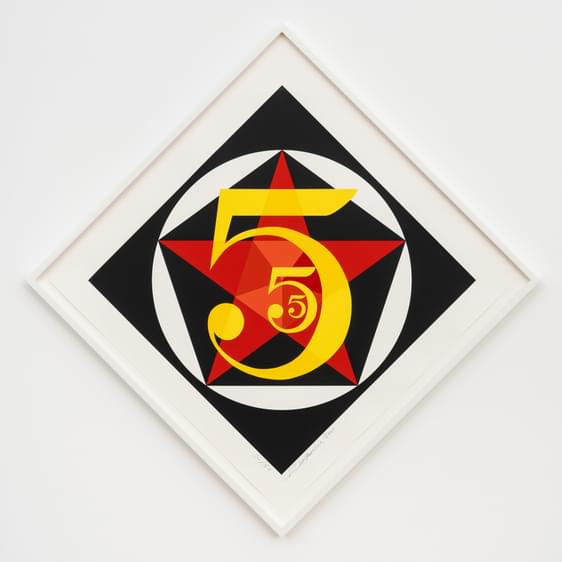Press Story
Yorkshire Sculpture Park presents a sale of exceptional original prints by Robert Indiana, from Gillian and Simon Salama-Caro of The Robert Indiana Legacy Initiative. Hosted at Hauser & Wirth London, the sale supports the charitable aims of Yorkshire Sculpture Park (YSP).
Through the generosity of Gillian and Simon Salama-Caro, all proceeds from the Robert Indiana Print Benefit Exhibition will support the ongoing charitable work of YSP. The exhibition features 19 previously unreleased serigraphs signed by the artist and printed 2001-11.
This significant group of works highlights some of Indiana’s pivotal and enduring themes, including his iconic series LOVE, his focus towards the subject of numbers, and a tribute to the slips, an area of Manhattan where he lived and began his artistic career. The exhibition also introduces early depictions of Marilyn Monroe as a symbol of American popular culture and celebrity, and its sometimes-tragic consequences.
Indiana began printmaking in the mid-1960s. In the late 1980s and early 1990s he worked on several projects with Robert Blanton of Brand X Editions in New York, before later reconnecting with the master printer in 2000. This is the first time that a significant group of these limited-edition serigraphs is being exhibited together, presenting a rare opportunity to own works that have never previously been offered on the open market. Each serigraph relates directly to a painting made by Indiana between the years 1959 and 1999 and chosen by the artist for a limited-edition screen print. The works shown in this exhibition were published by G & S Editions (Gillian and Simon Salama-Caro).
In common with many cultural organisations, YSP faces considerable financial strain. Director Clare Lilley, said, “The proceeds from this sale will directly benefit the work of Yorkshire Sculpture Park and our mission to bring outstanding art, landscape and learning to diverse people. For three generations we have contributed to the quality of life in our region and to Britain’s ecosystem of contemporary sculpture, but we are working in precarious times. I’m hugely grateful to Gillian and Simon Salama-Caro for their heartfelt belief in YSP, which is marked by such generosity, and to our friends at Hauser & Wirth for so readily supporting this important endeavour. This is a joyful coming together of public and private, individual and institution, for the public good.”
Simon Salama-Caro, said, “Yorkshire Sculpture Park holds a special place in our hearts and minds. Gillian and I came to know well Clare and the YSP team during their insightful curation and presentation of Robert Indiana: Sculpture 1958-2018, the first major exhibition in the UK of sculpture, painting, and prints by Bob. We are proud that these works will both help YSP fulfill its mission and serve as part of our ongoing commitment to raise awareness of and appreciation for the work of Robert Indiana.”
Neil Wenman, Global Creative Director and Partner, Hauser & Wirth, said, “We are delighted to be supporting YSP, a museum that has worked with so many of our beloved artists and who shares the gallery’s ethos for fostering dialogue, creativity and discovery among the widest possible range of audiences. Over the past years, our London gallery has hosted several charitable and educational events and initiatives for UK organisations and institutions, including Hospital Rooms and South London Gallery. We are thrilled to now support our friends at Yorkshire Sculpture Park with this benefit print sale, with all proceeds going to their charitable aims.”
Featured works:
The Slips (2001) commemorates the eight marine slips in Indiana’s lower Manhattan neighbourhood: Coenties Slip, Old Slip, Burling Slip, Peck Slip, Catharine Slip, Market Slip, Pike Slip, and Rutgers Slip. These slips were created by 18th century Dutch settlers and were central to New York’s role as a major port; they have all been filled in to become streets. A forgotten pocket in New York, where the remains of a bustling maritime past rubbed up against the burgeoning financial sector, Coenties Slip provided a home to Indiana and a connection to a notable artistic community, including Agnes Martin, Ellsworth Kelly, Lenore Tawney and James Rosenquist, that would alter the personal and professional trajectory of his young life.
The Small Diamond Demuth Five (2001) is based on the smallest of Indiana’s paintings which pays homage to American modernist Charles Demuth’s painting I Saw the Figure 5 in Gold (1928), in the collection of the Metropolitan Museum of Art, New York. Demuth’s painting is a direct response to his friend, the poet William Carlos Williams’ poem The Great Figure. Indiana’s work entwines him with two other important gay artists from an earlier generation.
The Love Marilyn (2008), The Black Marilyn (2001), Marilyn, Marilyn (2008), and Ms. America (2008), all relate to a series of paintings in which Marilyn Monroe is the principal subject. Indiana painted his first Monroe themed work in 1967 and returned to the subject over thirty years later, inspired by the many books published around the thirty-fifth anniversary of the actress’s death, the death of Joe DiMaggio, and President Bill Clinton’s affair with Monica Lewinsky.
The Great LOVE (2008) works are smaller scale ‘pendants’ of Indiana’s monumental four panel canvas, The Great LOVE (1966). These works belong to a series of paintings, sculptures and prints dedicated to the theme of love that the artist began in the mid-1960s, and highlight Indiana’s fascination with symmetry, colour, and form. Since its inception, Indiana’s distinctive rendering of “love” as both a word and an image has captured the popular imagination and become one of the most immediately recognisable works of art in the world.
The Decade: Autoportrait (2001-11) serigraphs are based on a group of ten symbolic self-portraits layered with a multitude of references that form a poetic retrospective of Indiana’s life during the 1960s. By titling these works Autoportrait, Indiana plays on the concept of the self-portrait, infusing it with references to his childhood growing up Indiana, where the automobile played a significant role as a major industrial product of the area and as the vehicle that helped shape his view of the culture of US highways.
Download the press release
High Res Image Downloads
- JPG

Robert Indiana, Decade Autoportrait 1967, 2011 © Robert Indiana. Image courtesy of The Robert Indiana Legacy Initiative, Gillian and Simon Salama-Caro and Yorkshire Sculpture Park.
403 KB - JPG

Robert Indiana, The Black Marilyn, 2001, serigraph, Image courtesy of The Robert Indiana Legacy Initiative LLC. Artwork © 2024 Morgan Art Foundation LLC/Artists Rights Society (ARS), NY/DACS (UK).
1.6 MB - JPG

Robert Indiana, Marilyn Marilyn, 2008, serigraph
1.7 MB - JPG

Robert Indiana, The Great LOVE (Red Blue Green), 2008, Serigraph, 45 x 44 inches (114.3 x 112 cm). Image courtesy of The Robert Indiana Legacy Initiative LLC. Artwork © 2024 Morgan Art Foundation LLC/Artists Rights Society (ARS), NY/DACS (UK).
105 KB - JPG

Robert Indiana, Decade: Autoportrait 1961, 2001, Serigraph, 37 x 36 inches (94 x 91.4 cm). Image courtesy of The Robert Indiana Legacy Initiative LLC. Artwork © 2024 Morgan Art Foundation LLC/Artists Rights Society (ARS), NY/DACS (UK).
187 KB - JPG

Robert Indiana, The Small Diamond Demuth Five, 2001, serigraph
1.3 MB